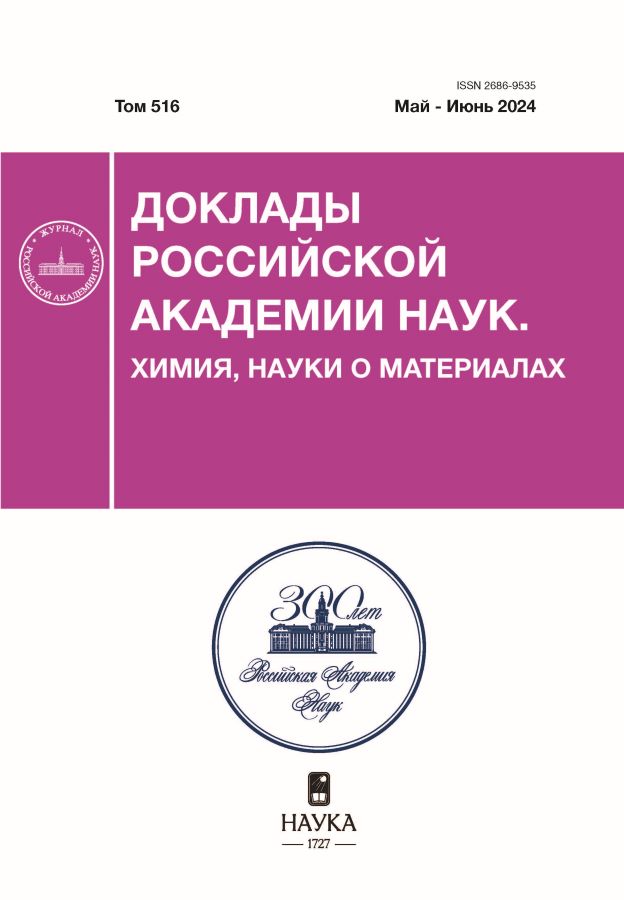The structure of humates in aqueous solutions and their biological activity
- Авторлар: Fedotov G.N.1, Shoba S.A.1, Gorepekin I.V.1, Gracheva T.A.1, Kachalkin A.V.1,2, Konkina U.A.1, Ushkova D.A.1
-
Мекемелер:
- Faculty of Soil Science of Lomonosov Moscow State University
- Institute of Biochemistry and Physiology of Microorganisms named after G. K. Scriabin, Federal Research Center “Pushchinsky Scientific Center for Biological Research of the Russian Academy of Sciences”
- Шығарылым: Том 516, № 1 (2024)
- Беттер: 39-44
- Бөлім: PHYSICAL CHEMISTRY
- URL: https://ter-arkhiv.ru/2686-9535/article/view/651907
- DOI: https://doi.org/10.31857/S2686953524030057
- EDN: https://elibrary.ru/ZIGNPT
- ID: 651907
Дәйексөз келтіру
Аннотация
When studying humate solutions, it is often not taken into account that humic substances (HS) can form supramolecular formations (SMFs) from molecular particles. These SMFs are highly stable, that is, the particles-molecules of HS do not separate from them spontaneously. It follows that at concentrations of the existence of SMFs, it is they, and not the particles-molecules of HS, that should be in solutions and determine their properties. The purpose of the study is to assess the influence of the form of existence of HS in solutions on their physico-chemical properties and biological activity. Solutions of sodium humate from brown coal were used in the work. The experimental results showed that with an increase in the concentration of humates, an abrupt increase in pH in the range of 30–50 mg l⁻¹ is observed. These concentrations correspond to the literature data on changes in the structure of HC in solutions: at concentrations above 30 mg l⁻¹ – barrier concentration – HS molecules form SMFs by self-assembly. Both molecular particles and SMFs, due to the diphilicity of HS, have the properties of surfactants. That is, in solutions at the interface of the “water–air” phases, HS films form. The strength of the films depends on the size of its constituent particles and the speed of their movement from the thickness to the surface of the solution. When plotting graphs in the coordinates “Film formation time in hours–Log humate concentration, mg l⁻¹”, a jump corresponding to the barrier concentration was detected on the curves. It was also found that during foliar treatment of cucumber shoots with mechanoactivated humate solutions with concentrations below the barrier, the stimulation effect increases, apparently due to the transition from the existence of HS in solution in the form of SMFs to existence in the form of particles-molecules that, due to their small size, can penetrate plant cells.
Толық мәтін
Авторлар туралы
G. Fedotov
Faculty of Soil Science of Lomonosov Moscow State University
Хат алмасуға жауапты Автор.
Email: gennadiy.fedotov@gmail.com
Ресей, 119992 Moscow
S. Shoba
Faculty of Soil Science of Lomonosov Moscow State University
Email: gennadiy.fedotov@gmail.com
Corresponding Member of the RAS
Ресей, 119992 MoscowI. Gorepekin
Faculty of Soil Science of Lomonosov Moscow State University
Email: gennadiy.fedotov@gmail.com
Ресей, 119992 Moscow
T. Gracheva
Faculty of Soil Science of Lomonosov Moscow State University
Email: gennadiy.fedotov@gmail.com
Ресей, 119992 Moscow
A. Kachalkin
Faculty of Soil Science of Lomonosov Moscow State University; Institute of Biochemistry and Physiology of Microorganisms named after G. K. Scriabin, Federal Research Center “Pushchinsky Scientific Center for Biological Research of the Russian Academy of Sciences”
Email: gennadiy.fedotov@gmail.com
Ресей, 119992 Moscow; 142290 Pushchino
U. Konkina
Faculty of Soil Science of Lomonosov Moscow State University
Email: gennadiy.fedotov@gmail.com
Ресей, 119992 Moscow
D. Ushkova
Faculty of Soil Science of Lomonosov Moscow State University
Email: gennadiy.fedotov@gmail.com
Ресей, 119992 Moscow
Әдебиет тізімі
- Орлов Д.С. Гумусовые кислоты почв и общая теория гумификации. М.: Изд-во МГУ, 1990. с. 325.
- Österberg R., Mortensen K. // Eur. Biophys. J. 1992. V. 21. № 3. P. 163–167. https://doi.org/10.1007/BF00196759
- Angelico R., Colombo C., Di Iorio E., Brtnický M., Fojt J., Conte P. // Appl. Sci. 2023. V. 13. № 4. 2236. https://doi.org/10.3390/app13042236
- Senesi N., Wilkinson K.J. Biophysical chemistry of fractal structures and processes in environmental systems. Senesi N., Wilkinson K.J. (Eds.). John Wiley & Sons Ltd., 2008. p. 342.
- Федотов Г.Н., Шеин Е.В., Ушкова Д.А., Салимгареева О.А., Горепекин И.В., Потапов Д.И. // Почвоведение. 2023. № 8. С. 903–908. https://doi.org/10.31857/S0032180X22601608
- Милановский Е.Ю. Гумусовые вещества почв как природные гидрофобно-гидрофильные соединения. М.: ГЕОС. 2009. с. 186.
- Nardi S., Pizzeghello D., Muscolo A., Vianello A. // Soil Biol. Biochem. 2002. V. 34. №. 11. P. 1527–1536. https://doi.org/10.1016/S0038-0717(02)00174-8
- Asli S., Neumann P.M. // Plant Soil. 2010. V. 336. P. 313–322. https://doi.org/10.1007/s11104-010-0483-2
- Scherrer R., Louden L., Gerhardt P. // J. Bacteriol. 1974. V. 118. № 2. P. 534–540. https://doi.org/10.1128/jb.118.2.534-540.1974
- De Nobel J.G., Barnett J.A. // Yeast. 1991. V. 7. № 4. P. 313–323. https://doi.org/10.1002/yea.320070402
- Visser S.A. // Soil Biol. Biochem. 1985. V. 17. № 4. P. 457–462. https://doi.org/10.1016/0038-0717(85)90009-4
- Fasurová N., Čechlovská H., Kučerik J. // Pet. Coal. 2006. V. 48. № 2. P. 24–32.
- Евдокимов И.П., Лосев А.П. Природные нанообъекты в нефтегазовых средах. М.: РГУ нефти и газа им. И.М. Губкина, 2008. с. 104.
- Arachchige M.S.A., Mizutani O., Toyama H. // Biotechnol. Biotechnol. Equip. 2019. V. 33. № 1. P. 1505–1515. https://doi.org/10.1080/13102818.2019.1676167
- Spaccini R., Piccolo A., Conte P., Haberhauer G., Gerzabek M.H. // Soil Biol. Biochem. 2002. V. 34. № 12. P. 1839–1851. https://doi.org/10.1016/S0038-0717(02)00197-9
- Воюцкий С.С. Курс коллоидной химии. М.: Химия, 1975. с. 512.
- Sampaio J.P. // Can. J. Microbiol. 1999. V. 45. № 6. P. 491–512. https://doi.org/10.1139/w99-020
- Tikhonov V.V., Yakushev A.V., Zavgorodnyaya Y.A., Byzov B.A., Demin V.V. // Eurasian Soil Sci. 2010. V. 43. P. 305–313. https://doi.org/10.1134/S1064229310030087
Қосымша файлдар













